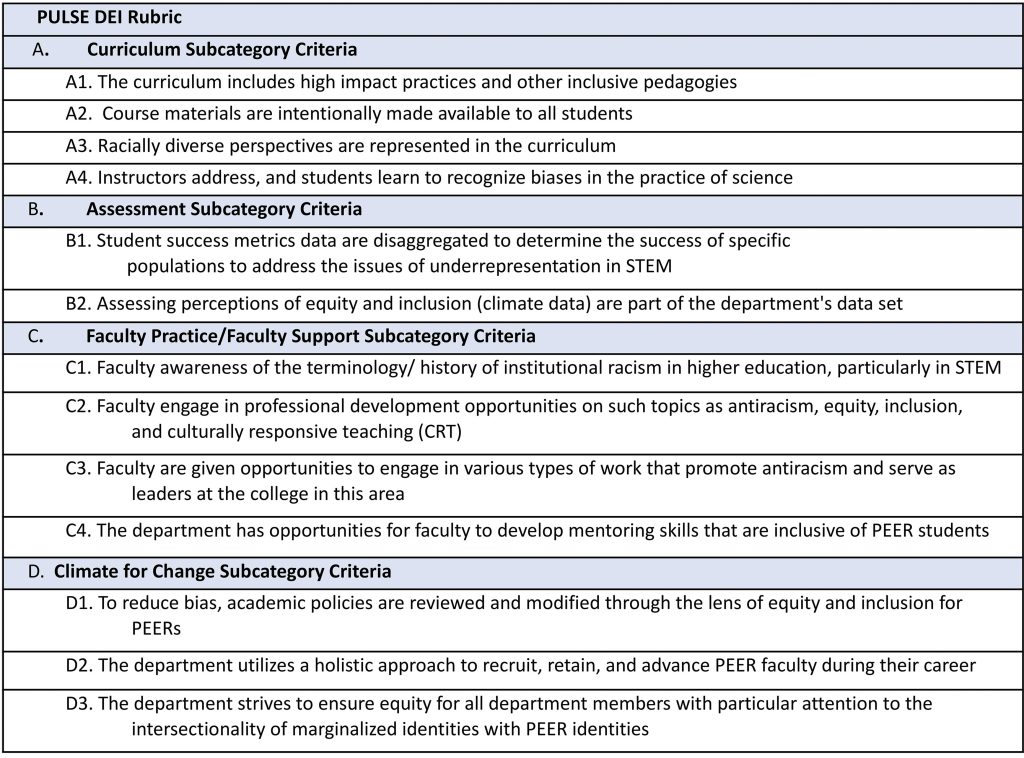by Anzela Niraula
While the drive to address and tackle the structural barriers facing DEI is palpable in higher education, it is often difficult to know where and how to approach this enormous topic. The PULSE DEI rubric, developed by Brancaccio-Taras and colleagues, seeks to specifically empower departments to advance DEI at their institutions. This rubric is the sixth and newest addition to PULSE’s preexisting rubrics from which it derives its framework.
The PULSE DEI rubric centers on anti-racism by specifically considering persons excluded due to ethnicity or race (PEERs). This focus is aimed at creating a concrete and narrow plan, and avoiding the logistical complexities associated with multiple identities, while simultaneously creating better conditions for other identities through an intersectional lens. While at first glance the lack of emphasis on other marginalized identities may seem odd, this targeted approach may indeed create effective DEI initiatives as a first step, which could then be expanded to explicitly include multiple identities.
The DEI rubric contains 13 items divided into 4 subcategories (see figure). I found the Assessment subcategory particularly thoughtful as it seeks to identify student success rates within specific populations while simultaneously using a climate survey to assess students’ perceptions of equity and inclusion. These two components are complementary in that one helps identify issues, and the other determines the effectiveness of measures taken to address those issues. The figure below provides a summary of the actual rubric (easily accessible on the PULSE website) that contains detailed context, definitions, and resources to further guide departments.

The figure reproduced from Brancaccio-Taras et al. summarizes the PULSE DEI rubric criteria grouped under the four subcategories: A. Curriculum Subcategory Criteria, B. Assessment Subcategory Criteria, C. Faculty Practice/Faculty Support Subcategory Criteria, and D. Climate for Change Subcategory Criteria.
Each item on the rubric is scored on a 0-4 scale (0 = baseline, 1 = beginning, 2 = developing, 3 = accomplished, and 4 = exemplar). Notably, the rubric utilizes consensus scores rather than average scores for each criterion, which by design requires – and hopefully promotes – deep reflections and constructive discussions within departments. I wonder what measures could be placed to ensure honest and fair conversations, as power dynamics within departments could easily sway these important discussions. It would be ironic to have to develop another rubric to ensure the discussions happen in good faith.
I will be sharing with friends and colleagues this DEI rubric as a tool for identifying specific areas of attention and for ongoing progress assessments within departments. From a long-term perspective, it would be truly transformative to have departmental initiatives and successes eventually be incorporated into core institutional policies at all levels.
Brancaccio-Taras, L., Awong-Taylor, J., Linden, M., Marley, K., Reiness, C.G., Uzman, J.A., 2022. The Pulse Diversity Equity and Inclusion (DEI) rubric: A tool to help assess departmental DEI efforts. Journal of Microbiology & Biology Education. doi:10.1128/jmbe.00057-22

